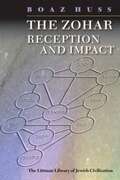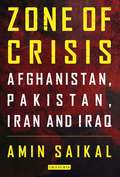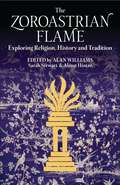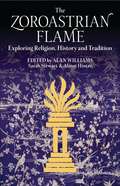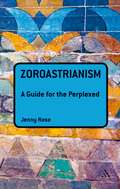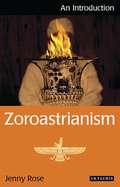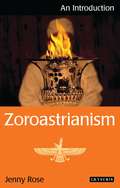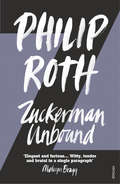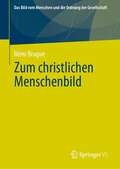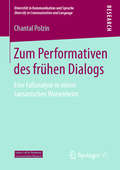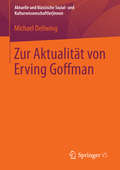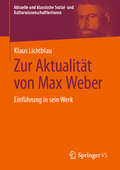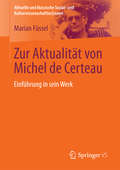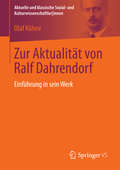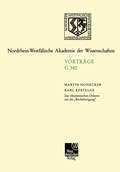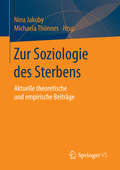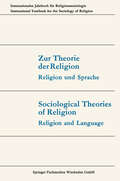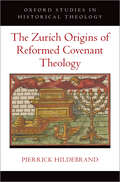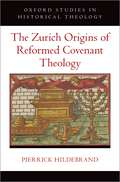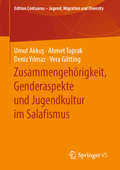- Table View
- List View
The Zohar: Reception and Impact (The Littman Library of Jewish Civilization)
by Boaz HussNational Jewish Book Awards Finalist for the Nahum N. Sarna Memorial Award for Scholarship, 2016.From its first appearance, the Zohar has been one of the most sacred, authoritative, and influential books in Jewish culture. Many scholarly works have been dedicated to its mystical content, its literary style, and the question of its authorship. This book focuses on different issues: it examines the various ways in which the Zohar has been received by its readers and the impact it has had on Jewish culture, including the fluctuations in its status and value and the various cultural practices linked to these changes. This dynamic and multi-layered history throws important new light on many aspects of Jewish cultural history over the last seven centuries. Boaz Huss has broken new ground with this study, which examines of the reception and canonization of the Zohar as well as its criticism and rejection from its inception to the present day. His underlying assumption is that the different values attributed to the Zohar are not inherent qualities of the zoharic texts, but rather represent the way it has been perceived by its readers in different cultural contexts. He therefore considers not only the attribution of different qualities to the Zohar through time but also the people who were engaged in attributing such qualities and the social and cultural functions associated with their creation, re-creation, and rejection. For each historical period from the beginning of Zohar scholarship to the present, Huss considers the social conditions that stimulated the veneration of the Zohar as well as the factors that contributed to its rejection, alongside the cultural functions and consequences of each approach. Because the multiple modes of the reception of the Zohar have had a decisive influence on the history of Jewish culture, this highly innovative and wide-ranging approach to Zohar scholarship will have important repercussions for many areas of Jewish studies.
Zombies in Western Culture: A Twenty-First Century Crisis
by John Vervaeke Filip Miscevic Christopher MastropietroWhy has the zombie become such a pervasive figure in twenty-first-century popular culture? John Vervaeke, Christopher Mastropietro and Filip Miscevic seek to answer this question by arguing that particular aspects of the zombie, common to a variety of media forms, reflect a crisis in modern Western culture. The authors examine the essential features of the zombie, including mindlessness, ugliness and homelessness, and argue that these reflect the outlook of the contemporary West and its attendant zeitgeists of anxiety, alienation, disconnection and disenfranchisement. They trace the relationship between zombies and the theme of secular apocalypse, demonstrating that the zombie draws its power from being a perversion of the Christian mythos of death and resurrection. Symbolic of a lost Christian worldview, the zombie represents a world that can no longer explain itself, nor provide us with instructions for how to live within it. The concept of 'domicide' or the destruction of home is developed to describe the modern crisis of meaning that the zombie both represents and reflects. This is illustrated using case studies including the relocation of the Anishinaabe of the Grassy Narrows First Nation, and the upheaval of population displacement in the Hellenistic period. Finally, the authors invoke and reformulate symbols of the four horseman of the apocalypse as rhetorical analogues to frame those aspects of contemporary collapse that elucidate the horror of the zombie. Zombies in Western Culture: A Twenty-First Century Crisis is required reading for anyone interested in the phenomenon of zombies in contemporary culture. It will also be of interest to an interdisciplinary audience including students and scholars of culture studies, semiotics, philosophy, religious studies, eschatology, anthropology, Jungian studies, and sociology.
Zone of Crisis: Afghanistan, Pakistan, Iran and Iraq
by Amin SaikalThe West Asian states of Afghanistan, Pakistan, Iraq and Iran have over the last few decades represented an arc of crisis. Characterised by fractured and dysfunctional political elites, fraught economic policies, and ideological struggles between the forces of authoritarianism and democratisation, neo-fundamentalism and pluralism, they embody a mosaic of ethnicities. Amin Saikal, a distinguished Afghan-born scholar of international affairs, provides a sweeping new understanding of the complex contemporary political and social instability encompassing the region. Critically comparing democratisation and counter-insurgency efforts in Afghanistan, Iraq and Pakistan, and examining both recent Western intervention and the history of foreign influence in the region, Saikal looks at how US entanglement has affected Pakistani and Iranian domestic politics and foreign affairs. How has this influenced the success or failure of the occupation in Afghanistan and Iraq? What solutions can be taken to ensure regional security? An informed and balanced overview on a troubled region, this book will fascinate general readers and prove essential reading for specialists.
The Zoroastrian Flame: Exploring Religion, History and Tradition
by Sarah Stewart Alan Williams Almut HintzeFor many centuries, from the birth of the religion late in the second millennium BC to its influence on the Achaemenids and later adoption in the third century AD as the state religion of the Sasanian Empire, it enjoyed imperial patronage and profoundly shaped the culture of antiquity. The Magi of the New Testament most probably were Zoroastrian priests from the Iranian world, while the enigmatic figure of Zarathushtra (or Zoroaster) himself has exerted continual fascination in the West, influencing creative artists as diverse as Voltaire, Nietzsche, Mozart and Yeats. This authoritative volume brings together internationally recognised scholars to explore Zoroastrianism in all its rich complexity. Examining key themes such as history and modernity, tradition and scripture, art and architecture and minority status and religious identity, it places the modern Zoroastrians of Iran, and the Parsis of India, in their proper contexts. The book extends and complements the coverage of its companion volume, The Everlasting Flame.
The Zoroastrian Flame: Exploring Religion, History and Tradition (Library Of Modern Religion Ser.)
by Alan Williams Sarah Stewart Almut HintzeZoroastrianism has always commanded interest way beyond the circles of its actual adherents. Its unbroken history, remarkable texts and distinctive beliefs span three millennia, making it one of the world's most venerable faiths. For many centuries, from the birth of the religion late in the second millennium BC to its influence on the Achaemenids and later adoption in the third century AD as the state religion of the Sasanian Empire, it enjoyed imperial patronage and profoundly shaped the culture of antiquity. The Magi of the New Testament most probably were Zoroastrian priests from the Iranian world, while the enigmatic figure of Zarathushtra (or Zoroaster) himself has exerted continual fascination in the West, influencing creative artists as diverse as Voltaire, Nietzsche, Mozart and Yeats. This authoritative volume brings together internationally recognised scholars to explore Zoroastrianism in all its rich complexity. Examining key themes such as history and modernity, tradition and scripture, art and architecture and minority status and religious identity, it places the modern Zoroastrians of Iran, and the Parsis of India, in their proper contexts. The book extends and complements the coverage of its companion volume, The Everlasting Flame.
Zoroastrianism: An Introduction to an Ancient Faith (The Sussex Library of Religious Beliefs & Practice)
by Peter ClarkThis book sets out clearly and succinctly the major beliefs and practices which inform Zoroastrianism today.
Zoroastrianism: A Guide for the Perplexed (Guides for the Perplexed)
by Jenny RoseThe significance of the Zoroastrian religion in the development of the history of thought is often only mentioned in passing, or is completely overlooked. Zoroastrianism has developed over a span of at least three thousand years, with roots in a common Indo-Iranian culture and mythology, then becoming part of imperial Iranian ideology within an Ancient Near Eastern setting, and emerging in variant forms in western and central Asia in late antiquity. The religion continues as a living faith for an estimated 130 - 150,000 adherents in the world.Most Zoroastrians if asked, 'In a nutshell, what do Zoroastrians believe?' would begin their answer with the moral maxim: 'Good Thoughts, Good Words, Good Deeds.' Zoroastrianism: A Guide for the Perplexed takes this foundational trifold ethic as the framework for its three main chapters. The book presents a comprehensive study of the religion through its focus on the questions that perplexed seekers might ask of a Zoroastrian concerning ideology and ethics; current discussions of 'text' and 'author'; and the putting-into-practice of the religion.
Zoroastrianism: A Guide for the Perplexed (Guides for the Perplexed)
by Jenny RoseThe significance of the Zoroastrian religion in the development of the history of thought is often only mentioned in passing, or is completely overlooked. Zoroastrianism has developed over a span of at least three thousand years, with roots in a common Indo-Iranian culture and mythology, then becoming part of imperial Iranian ideology within an Ancient Near Eastern setting, and emerging in variant forms in western and central Asia in late antiquity. The religion continues as a living faith for an estimated 130 - 150,000 adherents in the world.Most Zoroastrians if asked, 'In a nutshell, what do Zoroastrians believe?' would begin their answer with the moral maxim: 'Good Thoughts, Good Words, Good Deeds.' Zoroastrianism: A Guide for the Perplexed takes this foundational trifold ethic as the framework for its three main chapters. The book presents a comprehensive study of the religion through its focus on the questions that perplexed seekers might ask of a Zoroastrian concerning ideology and ethics; current discussions of 'text' and 'author'; and the putting-into-practice of the religion.
Zoroastrianism: An Introduction
by Jenny RoseZoroastrianism is one of the world's great ancient religions. In present-day Iran, significant communities of Zoroastrians (who take their name from the founder of the faith, the remarkable religious reformer Zoroaster) still practise the rituals and teach the moral precepts that once undergirded the officially state-sanctioned faith of the mighty Sasanian empire. Beyond Iran, the Zoroastrian disapora is significant especially in India, where the Gujurati-speaking community of exiles from post-Sasanian Iran call themselves 'Parsis'. But there are also significant Zoroastrian communities to be found elsewhere, such as in the USA, Britain and Canada, where western cultural contexts have shaped the religion in intriguing ways and directions. This new, thorough and wide-ranging introduction will appeal to anyone interested in discovering more about the faith that bequeathed the contrasting words 'Magi' and 'magic', and whose adherents still live according to the code of 'Good Thoughts, Good Words, Good Deeds.'The central Zoroastrian concept that human beings are continually faced with a choice between the path of 'good' and 'evil', represented by the contrasting figures of Ahura Mazda and Ahriman, inspired thinkers as diverse as Voltaire, Mozart and Nietzsche. Jenny Rose shows why Zoroastrianism remains one of the world's most inspiring and perennially fascinating systems of ethics and belief.
Zoroastrianism: An Introduction (I.B.Tauris Introductions to Religion)
by Jenny RoseZoroastrianism is one of the world's great ancient religions. In present-day Iran, significant communities of Zoroastrians (who take their name from the founder of the faith, the remarkable religious reformer Zoroaster) still practise the rituals and teach the moral precepts that once undergirded the officially state-sanctioned faith of the mighty Sasanian empire. Beyond Iran, the Zoroastrian disapora is significant especially in India, where the Gujarati-speaking community of emigrants from post-Sasanian Iran call themselves 'Parsis'. But there are also significant Zoroastrian communities to be found elsewhere, such as in the USA, Britain and Canada, where western cultural contexts have shaped the religion in intriguing ways and directions. This new, thorough and wide-ranging introduction will appeal to anyone interested in discovering more about the faith that bequeathed the contrasting words 'Magi' and 'magic', and whose adherents still live according to the code of 'Good Thoughts, Good Words, Good Deeds.' The central Zoroastrian concept that human beings are continually faced with a choice between the path of 'good' and 'evil', represented by the contrasting figures of Ahura Mazda and Ahriman, inspired thinkers as diverse as Voltaire, Mozart and Nietzsche. Jenny Rose shows why Zoroastrianism remains one of the world's most inspiring and perennially fascinating systems of ethics and belief.'Jenny Rose's lively and engaging account comprises a very readable, well informed survey of Zoroastrianism and its history. The book is a pleasure to read throughout, and the author's writing style is markedly beautiful, placing her very much within Mary Boyce's literary tradition. Rose has read widely round the subject, engaging with important primary and secondary sources and rendering her thorough treatment of Zoroastrianism fully up-to-date. I particularly welcomed her valuable discussion of Zoroastrianism in Central Asia. All in all, the book is a fine example of considered synthesis and compression. This is a book one wants to read from beginning to end without putting it down. It will find a warm welcome from students of the subject and their teachers.'- Almut Hintze, Zartoshty Professor of Zoroastrianism, SOAS, University of London
Zoroastrianism in India and Iran: Persians, Parsis and the Flowering of Political Identity
by Alexandra BuhlerIn the nineteenth century, a number of Zoroastrians emigrated from Iran to India. The subsequent importance of the cultural, religious and political ties between the Zoroastrian communities of Iran and the Zoroastrian communities of India has long been recognised. But despite this, there has been little scholarly attention paid to the changing dynamics of this transnational relationship. This book examines the Zoroastrian community in the late Qajar and early Pahlavi period beyond the borders of Iran to trace this Parsi-Persian relationship. A major theme is the increase in philanthropy directed to the Zoroastrians of Iran by the Parsis and the involvement of the British in encouraging Parsi feelings of patriotism towards Iran. The book shows that not only were Parsis affected by events taking place in Iran, they also contributed to the broader change in attitudes towards Zoroastrians in that country. Using a variety of original sources from Britain, India and Iran, Alexandra Buhler looks at the political, legal, and social position of Zoroastrians in Iran and how different events impacted their attitudes as well as the attitudes of Parsis towards their ancestral homeland. Of particular significance, this book shows, are the seminal years of the Iranian Constitutional Revolution (1906-11) and the rise in the glorification of the pre-Islamic past, which culminated in the state nationalism expounded by Reza Shah. These political moments had a profound impact on how Zoroastrians in India felt about their future in the country and reveal a complex web of relations between the Parsis, the Zoroastrians of Iran, and the British.
Zoroastrianism in India and Iran: Persians, Parsis and the Flowering of Political Identity
by Alexandra BuhlerIn the nineteenth century, a number of Zoroastrians emigrated from Iran to India. The subsequent importance of the cultural, religious and political ties between the Zoroastrian communities of Iran and the Zoroastrian communities of India has long been recognised. But despite this, there has been little scholarly attention paid to the changing dynamics of this transnational relationship. This book examines the Zoroastrian community in the late Qajar and early Pahlavi period beyond the borders of Iran to trace this Parsi-Persian relationship. A major theme is the increase in philanthropy directed to the Zoroastrians of Iran by the Parsis and the involvement of the British in encouraging Parsi feelings of patriotism towards Iran. The book shows that not only were Parsis affected by events taking place in Iran, they also contributed to the broader change in attitudes towards Zoroastrians in that country. Using a variety of original sources from Britain, India and Iran, Alexandra Buhler looks at the political, legal, and social position of Zoroastrians in Iran and how different events impacted their attitudes as well as the attitudes of Parsis towards their ancestral homeland. Of particular significance, this book shows, are the seminal years of the Iranian Constitutional Revolution (1906-11) and the rise in the glorification of the pre-Islamic past, which culminated in the state nationalism expounded by Reza Shah. These political moments had a profound impact on how Zoroastrians in India felt about their future in the country and reveal a complex web of relations between the Parsis, the Zoroastrians of Iran, and the British.
Zuckerman Unbound: The Ghost Writer; Zuckerman Unbound; The Anatomy Lesson; The Prague Orgy (Vintage International Series #2)
by Philip RothFollowing the wild success of his novel, Carnovsky, Nathan Zuckerman has been catapulted into the literary limelight. As he ventures out onto the streets of Manhattan he finds himself accosted on all sides, the target of admonishers, advisers, would-be literary critics, and – worst of all – fans.An incompetent celebrity, ill at ease with his newfound fame, and unsure of how to live up to his fictional creation’s notoriety, Zuckerman flounders his way through a high-profile affair, the disintegration of his family life, and fends off the attentions of his most tenacious fan yet, as the turbulent decade of the sixties draws to a close around him.But beneath the uneasy glamour are the spectres of the recently murdered Robert Kennedy and Martin Luther King, Jr., and an unsettled Zuckerman feels himself watched…
Zum christlichen Menschenbild (Das Bild vom Menschen und die Ordnung der Gesellschaft)
by Rémi BragueDieses Buch entfaltet das christliche Menschenbild in seinen Umrissen. Die Frage nach dem Menschen verdient es nämlich, wieder neu gestellt zu werden, weil heute der ‚Humanismus‘ von einem zerstörerischen ‚Antihumanismus‘ bedroht ist.Warum besitzt der Mensch eine Würde und mithin Rechte? Die Antwort auf diese Frage fällt sehr unterschiedlich aus. Entsprechend unbestimmt, verschwommen und vieldeutig bleibt das Lippenbekenntnis zu Menschenwürde und Menschenrechten. Wer also ist jenes Lebewesen, das wir ‚Mensch‘ nennen? Jeder Versuch einer wissenschaftlichen ‚Definition‘ führt theoretisch und praktisch zu unmenschlichen Folgen, wie zahllose Beispiele in der Geschichte des 20. Jahrhunderts auf erschreckende Weise zeigen. Das christliche Menschenbild verzichtet auf eine solche Definition und zeichnet jene Kontur eines Vorbildes, auf die hin der Mensch in Christus seine vollkommene, abgeschlossene Gestalt gefunden hat.Die anthropologischen, sozialen und politischen Folgen eines so geprägten Menschenbildes werden in diesem Buch erörtert: als Plädoyer für die Achtung der Natur des Menschen, die nicht der eigenen Verfügungsgewalt noch der Beherrschung durch Dritte in die Hand gelegt ist.
Zum Performativen des frühen Dialogs: Eine Fallanalyse in einem tansanischen Waisenheim (Diversität in Kommunikation und Sprache / Diversity in Communication and Language)
by Chantal PolzinDie vorliegende Arbeit wendet den Blick auf das was geschieht, wenn die Anderen nicht von Beginn an anwesend sind und untersucht dies am Fall des Mädchens Radhia. Radhia lebt in einem tansanischen Waisenheim unter isolierenden Bedingungen, die auf ein komplexes Bedingungsgefüge zurückzuführen sind. Chantal Polzin initiiert und begleitet im Rahmen eines partizipativen Projekts den Dialogaufbau mit Radhia. Die Austauschprozesse werden mit dem Begriff der Performativität reflektiert und in der hierfür entwickelten relationalen Moment-Analyse untersucht. Mit diesem Einbezug in entwicklungspsychologische Kontexte öffnet sich eine breite interdisziplinäre Anschlussfähigkeit.
Zur Aktualität von Erving Goffman (Aktuelle und klassische Sozial- und Kulturwissenschaftler innen)
by Michael DellwingErving Goffmans zeitlose Klassiker liefern eine unprätentiöse, alltagsnahe und hinterlistige Soziologie: Er holt seine Leser an ihrer Alltagserfahrung ab, verfremdet diese langsam und führt sie so zu Grundeinsichten der Disziplin: Er zeigt an leicht nachvollziehbaren Szenen der face to face-Interaktion, wie bemerkenswert das scheinbar Unbemerkenswerte ist. Es geht Goffman um Erkenntnis der Tänze, Spiele, Rituale, Darstellungen - wie auch immer man es nennen mag - in denen wir uns in Interaktionen aufeinander beziehen und eine gemeinsame Realität sichern. Das geschieht immer im Wissen, dass diese Realität delikat und zerbrechlich ist und es an uns und unserer Handlung in Situationen liegt, sie zu sichern, Gesichter zu schützen und Stabilität zu leisten. Goffman legt das Skalpell an diese kleinen, unscheinbaren Interaktionen an und deckt so auf, welche Leistung und welcher Aufwand hinter dem steckt, was wir für selbstverständlich halten: was für ein kleines Wunder Alltagsinteraktion sein kann.
Zur Aktualität von Max Weber: Einführung in sein Werk (Aktuelle und klassische Sozial- und KulturwissenschaftlerInnen)
by Klaus LichtblauDieses Buch stellt die erste historisch-kritische Einführung in Max Webers Werk dar. Es beruht auf Forschungsergebnissen, die in den letzten vierzig Jahren im Umkreis der Max-Weber-Gesamtausgabe erzielt worden sind und ist insofern strikt werkgeschichtlich orientiert. Im Zentrum steht das soziologische Werk von Max Weber. Ferner werden auch seine methodologischen Schriften sowie seine religionsgeschichtlichen Arbeiten ausführlich dargestellt und diskutiert. Dabei wird aufgezeigt, dass sich die Aktualität seines Werkes dem Spannungsverhältnis zwischen Geschichte und Soziologie verdankt, das in ihm zum Ausdruck kommt.Der AutorProf. Dr. Klaus Lichtblau lehrte bis Frühjahr 2017 Soziologie am Fachbereich Gesellschaftswissenschaften der Goethe-Universität in Frankfurt am Main.
Zur Aktualität von Michel de Certeau: Einführung in sein Werk (Aktuelle und klassische Sozial- und Kulturwissenschaftler innen)
by Marian FüsselMichel de Certeau (1925-1986) war Zeit seines Lebens ein Grenzgänger zwischen den wissenschaftlichen Disziplinen: Von der Theologie über die Historische Anthropologie bis zur Psychoanalyse durchstreifte er verschiedenste Felder der Wissenschaften vom Anderen. Figuren der Alterität können als einigendes Band von de Certeaus Studien begriffen werden, die er anhand der frühneuzeitlichen Mystik ebenso entwickelte wie anhand der Geschichtstheorie oder der Kulturgeschichte der Stadt und des Konsums.
Zur Aktualität von Ralf Dahrendorf: Einführung in sein Werk (Aktuelle und klassische Sozial- und Kulturwissenschaftler innen)
by Olaf KühneDas Buch entfaltet den werkgeschichtlichen und bio-bibliografischen Hintergrund der wissenschaftlichen und publizistischen Tätigkeit von Ralf Dahrendorf. Es trägt damit entscheidend zur (Wieder-) Entdeckung eines der wichtigsten Soziologen der Bundesrepublik und des Liberalismus bei.
Zur ökumenischen Debatte um die „Rechtfertigung“: 425. Sitzung am 19. Januar 2000 in Düsseldorf (Rheinisch-Westfälische Akademie der Wissenschaften #380)
by Martin Honecker Karl KertelgeZur Soziologie des Sterbens: Aktuelle theoretische und empirische Beiträge
by Nina Jakoby Michaela ThönnesDer vorliegende Sammelband vereint aktuelle theoretische und empirische Beiträge einer Soziologie des Sterbens. Sterben ist keine allein physische und psychische, sondern auch eine soziale Wirklichkeit. Die Erfahrung der Begrenztheit des Daseins und damit auch der menschlichen Beziehungen, die besondere Emotionalität im Umgang mit dem Sterben und die Bedeutung entsprechender sozialer Interaktionen verweisen auf die allgemeine gesellschaftliche Bedeutung dieser letzten Lebensphase und ihrer soziologischen Erforschung. Sterben, Tod, Trauer und Erinnerung – die unterschiedlichen Perspektivierungen demonstrieren den Facettenreichtum und die soziologische Relevanz des Untersuchungsfelds Sterben.
Zur Theorie der Religion / Sociological Theories of Religion: Religion und Sprache / Religion and Language (Internationales Jahrbuch für Wissens- und Religionssoziologie/International yearbook for sociology of knowledge and religion #8)
by Günter Dux Thomas Luckmann Joachim MatthesThe Zurich Origins of Reformed Covenant Theology (Oxford Studies in Historical Theology)
by Pierrick HildebrandThis book offers a fresh interpretation of covenantal theology in the Reformation by demonstrating how the writings of the Zurich reformers Huldrych Zwingli (1484-1531) and his successor Heinrich Bullinger (1504-75) decisively shaped a foundation of the Reformed tradition. The book overturns previous research that has both emphasized Zurich's irreconcilability with later developments of Reformed covenant theology and downplayed the contribution of the Zurich theologians in favor of figures such as Philipp Melanchthon (1497-1560) and John Calvin (1509-64). It argues for the dependence of Calvin and other leading figures on Zurich and for continuity in the later Reformed tradition with its origins in the 1520s. Pierrick Hildebrand demonstrates that the concept of a prelapsarian covenant, generally used as an argument for discontinuity between Zurich and Heidelberg, was clearly present in Zwingli and Bullinger. Further, Bullinger's covenantal terminology, which integrates the concept of the covenant with union with Christ, was adopted by Calvin and later by the Heidelberg theologians. Rejecting the idea that Zurich and Geneva represented two different traditions, Hildebrand details significant continuities and agreement while paying attention to differences. To do this, he draws on printed texts but also makes extensive use of previously unexamined manuscript sources, such as commentaries and sermon notes, to provide a much fuller account of the origins of Reformed covenantal theology. Working across a range of literary genres and with careful attention to historical contexts, this book presents the evolution of a crucial part of Reformation thought in a new light.
The Zurich Origins of Reformed Covenant Theology (Oxford Studies in Historical Theology)
by Pierrick HildebrandThis book offers a fresh interpretation of covenantal theology in the Reformation by demonstrating how the writings of the Zurich reformers Huldrych Zwingli (1484-1531) and his successor Heinrich Bullinger (1504-75) decisively shaped a foundation of the Reformed tradition. The book overturns previous research that has both emphasized Zurich's irreconcilability with later developments of Reformed covenant theology and downplayed the contribution of the Zurich theologians in favor of figures such as Philipp Melanchthon (1497-1560) and John Calvin (1509-64). It argues for the dependence of Calvin and other leading figures on Zurich and for continuity in the later Reformed tradition with its origins in the 1520s. Pierrick Hildebrand demonstrates that the concept of a prelapsarian covenant, generally used as an argument for discontinuity between Zurich and Heidelberg, was clearly present in Zwingli and Bullinger. Further, Bullinger's covenantal terminology, which integrates the concept of the covenant with union with Christ, was adopted by Calvin and later by the Heidelberg theologians. Rejecting the idea that Zurich and Geneva represented two different traditions, Hildebrand details significant continuities and agreement while paying attention to differences. To do this, he draws on printed texts but also makes extensive use of previously unexamined manuscript sources, such as commentaries and sermon notes, to provide a much fuller account of the origins of Reformed covenantal theology. Working across a range of literary genres and with careful attention to historical contexts, this book presents the evolution of a crucial part of Reformation thought in a new light.
Zusammengehörigkeit, Genderaspekte und Jugendkultur im Salafismus (Edition Centaurus – Jugend, Migration und Diversity)
by Umut Akkuş Ahmet Toprak Deniz Yılmaz Vera GöttingDer Band stellt die Ergebnisse des Forschungsprojektes „Die jugendkulturelle Dimension des Salafismus aus der Genderperspektive“ vor und konzentriert sich dabei auf drei zentrale Forschungsfragen:Inwiefern werden jugendkulturelle Aspekte im Salafismus erfüllt?Welche Ursachen und Faktoren spielen bei dem religiösen Radikalisierungsprozess eine Rolle?Warum fühlen sich Mädchen und junge Frauen einer restriktiven Ideologie zugehörig, die eine strenge Geschlechtertrennung praktiziert?Das Forschungsprojekt mit einer Laufzeit von 2 Jahren (2017-2019) wurde vom Ministerium für Kultur und Wissenschaft des Landes Nordrhein-Westfalen gefördert. Die Forschungsergebnisse gehen auf Einzelinterviews sowie Gruppeninterviews mit Jugendlichen beiden Geschlechts im Alter von 14 – 27 Jahren aus unterschiedlichen Städten NRWs zurück.Der InhaltEinleitungTheoretischer HintergrundDas ForschungsprojektErgebnisse der UntersuchungPädagogische Handlungsempfehlungen für Politik und Zivilgesellschaft Die AutorenUmut Akkuş, wissenschaftlicher Mitarbeiter und Lehrbeauftragter an der Fachhochschule Dortmund.Dr. Ahmet Toprak, Professor für Erziehungswissenschaften an der Fachhochschule Dortmund.Deniz Yılmaz, wissenschaftliche Hilfskraft an der Fachhochschule Dortmund.Vera Götting, wissenschaftliche Hilfskraft an der Fachhochschule Dortmund.
